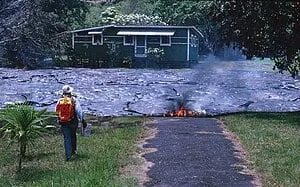Earth
Dwarves and earth hobbits have an affinity for digging holes in the ground. This is very useful for harvesting rock and soil, planting trees, building gardens, roads and paths, as well as providing material for rock and mortar construction of foundations and pillars, or dry laid rock construction such as traditional Hawaiian stone walls. The essential process of harvesting these useful materials is one of sorting.
My Precious:
Basaltic pahoehoe lava takes so many forms, that an astute hobbit or dwarf will always keep their minds even sharper than their digging tools, to see what treasures they may unearth… Naturally, when an orc digs out the same material using a diesel guzzling behemoth, all of these materials are broken and smashed together, and usually buried again without much thought…
Branch Molds:
Hollow cylindrical tubes form around tree trunks and branches, and occasionally a piece of one of these lava branch molds will come out of the earth intact. Like a piece of pipe made of rock, it can then be used in a variety of ways for interactive rock art construction, such as a rock pipe for a water fountain to emerge from, or a built-in sconce for holding a tiki torch.
Irridescence:
A rainbow of colors, plus gold and silver (reminiscent of mithril silver?) may be found on the underside of the lava flow. This is one beauty of a lava flow that the topsiders rarely see. Whole chunks of flow can be carefully excavated and used as facer rocks in wall construction to show off their beauty. Care is needed because these surfaces are woven of delicate strands of spun glass. Shards also break off these surfaces and can be collected for mosaic work.
Building rocks:
Tabular rocks for construction are flat on the top and bottom. They may be in their original chemically reduced state, appearing black or blue depending upon their density and air content, and this will affect their strength, with blue rock being the densest, heaviest, and hardest. Cinderized lava flows are red and softer, oxidized by pressure cooking with water content as a subsequent flow covers and reheats them. These rocks beg to be saved and used experimentally as bricks for the interior of beehive lava ovens, as well as floors for underground utility areas.
Rockfill:
Large irregular chunks of flow can be used as-is for filling equally deep depressions when constructing roadways into the forest edge, gaining access to harvest standing dead ohia trees, and build pleasant sites for wood hobbits and elves… As this construction progresses, large rocks are covered by progressively smaller rocks, resulting in a finished surface that is both stable and well-drained, with efficient use of material. Middle Earthlings take care to build roads that, when they are finished and naturalized, blend seamlessly into the terrain… After a short time, with a year-round growing season, a new arrival might never suspect that any work had gone into making The Shire so smooth and accessible. The humility inherent in such a subtle and service-oriented presentation perfectly balances the internal sense of pride in workmanship that comes with building a work of interactive art on the aina.
Riprap:

Photo of a house in Kalapana, Hawaii being destroyed by a pahoehoe flow. (Photo credit: Wikipedia)
If riprap construction is being done laying each rock by hand, the desired thickness, most often up to four inches, becomes the upper limit of the smallest dimension of the rock for purposes of sorting. Roadbeds laid in this way two millennia ago during the Roman Empire are still in use today! Hand-built roads at The Shire may not serve for that long, but only because they are likely to be covered by a fresh lava flow in about a thousand years or so…
Occasionally, three-inch rocks make a separate sorting pile, when just that amount of depth needs to be filled, but typically two-inch is an upper limit for filling similar depth potholes or as a top dressing on a freshly rubble-filled roadbed. Driving the tractor or a four-wheel-drive vehicle over the layer of two-inch rock will compact it into a nice stable road surface. Even on a slope, a runoff will not tend to wash out this size rock.
Gravel:
Gravel is the final icing on a roadway layer cake and is also perfect for finishing walking paths. Sorting size limits can be adjusted to the purpose at hand, but typically road gravel can be from about a quarter or half-inch up to three quarters or a full inch. When hand sorting, size categories can also be somewhat adjustable to the particular material makeup of each rock, so that a softer cinder that will break down when driven or walked on may be sorted into smaller size categories, reflecting its final size when put into active use. Similarly, the shape can be taken into account, so that a larger but thin rock can be sorted with smaller rocks, as it will tend to break and settle into a layer of smaller rocks. Esthetic considerations can even come into play, according to the desires of the interactive earth artist. A pallet of colors is available in our Middle Earth materials, from red cinder lava flows, cinders, and cinder soils, which have typically been oxidized by their water content when pressure cooked by a subsequent lava flow, to black and gray lava and cinders of varying shades, as well as blue rock, which is the densest and strongest material, lacking any air bubbles.
Soil:
Soil colors also range from the red cinder soil through yellows, various shades of brown to black depending upon the state of oxidation/reduction as well as organic carbon content. We also find chunks of ancient charcoal (biochar) buried for thousands of years underneath lava flows as we dig. These and the darker soils are particularly good for garden and agroforestry use, while more oxidized soils are fine as a top dressing for smoothing pasture and lawn areas.
